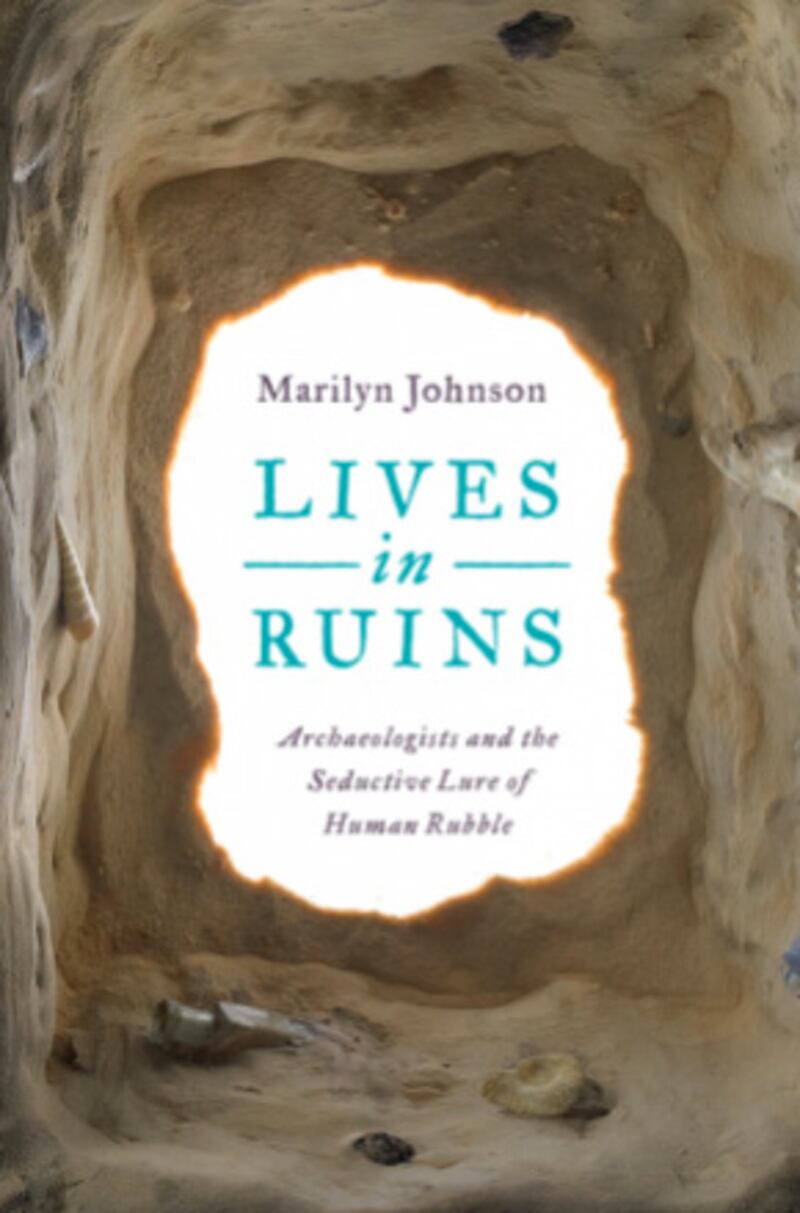Marilyn Johnson is a writer with a terrific capacity for learning. She’s endlessly curious and she also has a wonderful gift for turning her curiosity into writing that’s engaging and approachable. Her enthusiasm is infectious as evidenced in her first two books, which were about the subcultures of obituary writers and librarians respectively. Now she turns her attention to the mysterious world of archaeologists. Lives in Ruins: Archeologists and the Seductive Lure of Human Rubble has already been tabbed by Publisher’s Weekly as one of the 100 best books of the year.
Your first book was about people who write obituaries and your second was about librarians. This is your third book. What led you to archaeologists?
MJ: I thought it would be fun to go on a dig.
And is it?
MJ: It is! It totally is. I do feel a kinship with each of these professions. I wrote obituary tributes for several years for magazines, and wanted to know how real obit writers who worked on daily deadlines managed to breathe so much life into their writing. And I worked as a page for my public library as a teenager. I might have gone on to library science school, except when the board wouldn't raise my pay a nickel—from 95 cents an hour to $1—I quit out of pride. That ended my library career. I still hang out with librarians, though; they're my people.
And you still read obits all the time.
Are you kidding? I get most of my ideas from the obits. I read an obituary of Lewis Binford, for instance, who helped spark a revolution in archaeology in the U.S., and who was married six times, often to fellow archaeologists. Archaeology obits, I noticed, were full of curious facts and tantalizing history and places I didn’t recognize. I wondered who else was making a mark in the field in these turbulent times. I figured they had to be obsessed.
Did you ever want to be an archaeologist when you were a kid?
Sure. When I was young, I loved to dig and find and collect fossils. I was mad about archaeology. Who wasn't? But I jumped off the science track early, and took only one class in anthropology in college. I guess you'd call archaeology my fantasy profession, and though I have no gift for the work, I do share archaeologists' curiosity and stubbornness, and their enchantment with the past. Archaeologists, librarians, and obit writers—they all work passionately and for little personal reward to save bits of our cultural history. They all connect us to the people and objects and stories of our past.
The first time I ever heard about archaeology was in the fifth grade when we learned about Richard Leakey. Is he the big cultural touchstone?
Definitely. The Leakeys—Richard, his parents, Louis and Mary, and his wife Maeve and daughter Louise, are an archaeological dynasty. Richard, Maeve, and Louise are all affiliated with Stony Brook University, and John Shea, the Ice Age expert in the book, teaches down the hall and has been on site with them in Africa.
And while we’re talking pop culture, what do archaeologists think about Indiana Jones?
The archaeologists I met talked about Indiana Jones with real affection. He has given that profession a swagger that, let's face it, few other professions have. More than 30 years after Raiders of the Lost Ark, Indiana Jones is still luring people into the field, and Harrison Ford himself has been a sport—he served on the Archeological Institute of America's board for years. But the character is a cartoon, a plunderer, a throwback to an acquisition-oriented era as opposed to our current era, which emphasizes cultural heritage management and respect for native cultures. No archaeologist with any standing is going to talk seriously about some of the stuff in the movies, the crystal skulls and aliens and haunted artifacts. They know it's nonsense—but they appreciate the publicity.
So what makes an archaeologist in real life?
Resourcefulness. Curiosity. Physical sturdiness, mental toughness, and endurance. Patience. The capacity—not to mention, the desire!—to kneel all day in the sun inside a big hole, which might be a grave or a privy, while clouds of mosquitoes feast on you. Archaeologists have an uncanny ability to ignore the discomforts and channel the time period and the people they're studying. They have one foot in, say, the contemporary Caribbean sun with underbrush spreading in front of their eyes and bulldozers hovering, and one foot in the 18th century plantation that used to stand there.
And yet it’s such a physically demanding job.
It’s terribly hard on the body and some of the archaeologists reminded me of pirates: scarred, limping, sun-damaged, sweating under their rakish bandannas—and they do have a kind of pirate’s swagger. But how is it they never lose that hunger to turn over the next shovel of dirt? That amazes me. It’s the quest for the unknown. Once you have had the privilege of unearthing something that humans haven’t seen or touched for centuries, I think you get a kind of archaeological fever. I certainly got infected.
I was impressed by how many young and old people are in the profession. You’d think it’d require a young person’s stamina but that’s not the case.
The archaeologist Sarah Nelson is in her eighties, and she would go dig in China this minute if she could get grant money. She is a great role model and absolutely representative of the archaeologists I met in her indomitable drive. Nothing will stop her from figuring out novel and creative ways to apply her knowledge and get her hands on some unfiltered history.
You write about women as well as men. Even though the field was traditionally male dominated and women had to fight stereotyping, it's clear that some of the brightest and most prominent archaeologists are women. Did you consciously try to include a mix of men and women or did your nose just lead you to the most interesting and/or cooperative subjects?
Of course I tried to get a mix of archaeologists in all ways: male, female; ancient, classic, post-Colombian, and contemporary; academic, independent, and contract archaeologists. I included archaeologists in their twenties, several in their thirties and forties, a bunch in their fifties and sixties, one almost seventy, and one in her eighties. But my nose ruled. I was looking for characters, originals, people who could articulate what they were doing in colorful ways.
Also, about women, Nelson told you, "My archaeological writings presume that what women did in the past is recoverable and interesting." And you add: "And interesting. That she felt the need to add that phrase was telling. To some extent, archaeologists find what they're looking for, and if you never look for evidence of powerful women, even if the hills and valleys are full of queens and warriors, they'll be invisible." This brings up one of the book's central themes. That archaeology is subjective. That it's not comprehensive. History is written by the winners. But it seems to be as if archaeology is, in some sense, about honoring the losers' story, too, right?
This is one of the most subtle and touching aspects of the profession. Archaeology is about paying attention to things that have been or could be indetectable or invisible to others. As Joan Connelly said, "Good archaeology fills in the blanks of history. It tells the losers' stories. It teases out the history that falls between the cracks.” That, to me, is beautiful.
Do you think, by nature, archaeologists are drawn to the losers' stories?
I'm not sure if archaeologists are naturally drawn to "losers"—or can we call them overlooked people?
Yeah, that’s better because it doesn’t imply any kind of judgment. It’s about being neglected, overlooked.
That’s right. I’m drawn to such people, too. That’s probably obvious from the subjects of my previous books. Certainly the most interesting stories to me are the ones that have not yet been told. How did children live 2,000 years ago? Where are the women of ancient Greece? How did ordinary soldiers manage in colonial times? In the absence of written records, archaeology is one of the few ways to understand how these people lived, and even when there are written records, archaeology can add new evidence, or even contradict accepted history. Bill Sandy was surveying for a mall development in Fishkill, N.Y., when he uncovered the largest graveyard of the Revolutionary War soldiers that we know about. It’s part of the Fishkill Supply Depot, the largest and least-known supply center from that war. This is a tremendous find, not just because he discovered all these first veterans of our first war in a vacant lot. How did Washington and his generals keep those men and munitions hidden? How did they tend their dead and wounded in such secrecy?

What role does technology play in all of this?
The field is exploding, only partly because of technology—wars, climate change, and economic development are all tearing into the earth and giving us access to some of that buried history. But technology certainly helps. The use of satellite remote sensing by pioneers like Sarah Parcak and Douglas Comer has shown us sites we never knew were there, and tracked the erosion and degradation of others. There are increasingly sophisticated geophysical, chemical, and biological tests available— not to mention the crazy cases where archaeologists have been able to extract and analyze DNA material from ancient bones. But none of this is as magical as it sounds: the hard work of excavation and analysis still requires human verification and interpretation, “ground proof,” they call it. I agree with most of the archaeologists in Lives in Ruins: There’s no substitute for a trained field worker with a sharp eye and a simple trowel.
I found the section of the book on forensic archaeology fascinating.
The forensic archaeologist I dug with, Kimberlee Sue Moran, is attractive, young—she’s in her thirties—and perfectly at ease unearthing a murder victim crawling with maggots. She likes to emphasize that forensic archaeology is simply archaeology that can stand up in court: anything excavated or recovered has to be handled with gloves, uncontaminated, logged, identified, and accounted for at all times. You don't bag something and leave it by the trench while you go back to the truck for your lunch. If you can stomach lunch—forensic archaeology can be disgusting.
You were certainly challenged by your level of sea-worthiness a few times during the reporting of this book, weren’t you?
The gross stuff was incredibly gross. I learned some things I can never unlearn about organic decomposition and human bone. And now that you mention it, I also got seasick, and had altitude sickness, and had to be rescued a few times. But the killer bees that gave chase one day didn’t get me!
Earlier on you mentioned how secretive archaeologists are. Was it hard to get close to them?
Archaeologists are much harder to reach and get close to than the subjects of my other books. I mean, think about it: obit writers’ names are in the newspaper almost every day, and librarians are roaming around the library wearing big CAN I HELP YOU? buttons. Where are archaeologists? They’re scattered all over the world, anywhere humans have left their mark. They dislike cell phones and they are, for various practical reasons, somewhat secretive.
The archaeologists I did connect with were not interested in drive-by interviews. I didn't want that, either. I didn't want a few quotes from an underwater archaeologist; I wanted to see the sunken fleets and drowned artifacts through the archaeologist's eyes. It took years of groundwork to get next to some of them. In the book I admit, "I've lost count of the archaeologists I've chased who got away. They are an elusive bunch, in motion or in the thrall of another time. Even the ones who alight on a terraced ledge long enough to have a conversation would, before I knew it, shimmer like the good witch Glinda before evaporating into thin air."
What about Ruth Shady? Was she like your Bobby Fischer, your white whale?
Ha! Ruth Shady isn't my anything; she is her own, completely original force in archaeology. She is a Peruvian archaeologist who uncovered the oldest city in this hemisphere, and fought a very public feud with a couple of Americans. I don't blame her for not talking to me; she had no reason to trust Americans. I flew to Peru to hear her give a keynote speech at an international conference. I was hunkered down in my seat in the Municipalidad del Cuzco and thrilled—my heart was beating so fast!—and then ... no Shady. She didn't show up! Of course I was frustrated, but writers deal with disappointment all the time, and so do archaeologists. And I think it ended up being a funny way to tell her story. That’s who she is, after all, an archaeologist who ditched a couple hundred colleagues in her own backyard because she was too busy digging.
On the other hand, I interviewed Grant Gilmore with the hope that I could take his field school in the Caribbean in six months, and he said, Don’t wait. Come now. So I leapt. And I was so entertained by John Shea that I impulsively asked to take a class with him (though it meant a 160 mile commute twice a week)—and he said sure, here's a list of textbooks, see you next week.
Yeah, one thing that John Shea said struck me: "Narratives close off the complexity of reality." Then you go on to observe that we study archaeology "to gather authentic fragments of our human past, but the further back we go, the more we see what an incomplete picture we have of human history." There is so much mystery involved. How do archaeologists wrap an empirical mind around capturing history?
We’re conditioned by narrative to expect some resolution, whether it’s answers to our questions or solutions to a mystery. We expect a neat wrap-up to the story, but in fact there are many things we don’t understand and might never understand. Why were some people of the Iron Age tortured and their bodies thrown in bogs? How did the Inca get giant blocks of stone up mountains 500 years ago without the use of wheels? Why did earlier people go to all the trouble to build mounds? Laurie Rush, the military archaeologist, admitted, “Our most exciting days are the days we discover we were wrong.” The past is a wilderness that we’ve just begun to explore.
Are archaeologists in a rush or are they zenlike in taking all the time they need?
It depends on the archaeologist and the circumstances, but I think they would all take their sweet time if they could. They’re all trying to balance doing things in a timely fashion (and, if they're contract archaeologists, on the clock and on deadline) with doing things carefully, so as much information as possible is preserved, and other archaeologists coming behind them can re-examine the site in a few years or decades or eons. Then there’s Kathy Abbass, who has been preparing more than twenty years for the excavation of a fleet of historic ships sunk in Newport Harbor hundreds of years ago. She has to be able to preserve what she hauls up, and she’ll have only one chance to get it right. History will judge these people, so they want to get it right.






